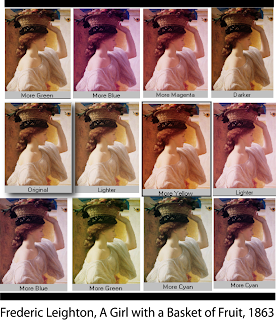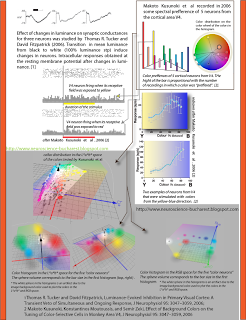Saturday, August 08, 2009
The Color of Neurons or The Color of Success
Posted by brain - research neuroscience group (a) Is there a combination of colors that will make our neurons fire like never before? :)
Which are the colors of success? What color combination will make your art popular? Maybe the colors shown below.

Can neuroscience tell something about what color combination will make our neurons to fire faster? Small differences in hue, or luminosity can make us prefer an image or another, as below.  Without talking about cultures, the subject of a painting or the composition of a 3D artwork, is there something in the hues that will make us stay longer in front of an artwork? Different hues activate different population of neurons. Is that why you prefer an image or another from the examples below?
Without talking about cultures, the subject of a painting or the composition of a 3D artwork, is there something in the hues that will make us stay longer in front of an artwork? Different hues activate different population of neurons. Is that why you prefer an image or another from the examples below?
 Without talking about cultures, the subject of a painting or the composition of a 3D artwork, is there something in the hues that will make us stay longer in front of an artwork? Different hues activate different population of neurons. Is that why you prefer an image or another from the examples below?
Without talking about cultures, the subject of a painting or the composition of a 3D artwork, is there something in the hues that will make us stay longer in front of an artwork? Different hues activate different population of neurons. Is that why you prefer an image or another from the examples below? Dozen of books can be written about the importance (or about the lack of importance) of hues in art, about their symbolism and the psychological effect. Our intention is to ask if there is something deeper inside of us that will choose an image or another as good because of the color used. Someone can say that the firs image is beautiful, but someone else can say that the second one is beautiful. Is this because of the color computations that take place in V1-V4 or in higher areas?
Dozen of books can be written about the importance (or about the lack of importance) of hues in art, about their symbolism and the psychological effect. Our intention is to ask if there is something deeper inside of us that will choose an image or another as good because of the color used. Someone can say that the firs image is beautiful, but someone else can say that the second one is beautiful. Is this because of the color computations that take place in V1-V4 or in higher areas? It is clear that in design (web design, print design, media) color matters. And all this fields mean high audience. In fine art different opinions were argued over time. Sometimes color is the ultimate way to express feelings , in other situations the color is just a third line instrument, and used just because it may fill some surfaces.
It is clear that in design (web design, print design, media) color matters. And all this fields mean high audience. In fine art different opinions were argued over time. Sometimes color is the ultimate way to express feelings , in other situations the color is just a third line instrument, and used just because it may fill some surfaces.All of us have color preferences and sometimes a color palette in an artwork will make us appreciate more an artwork, sometimes a specific color combination will create repulsion. This are the personal preferences. But some artworks are so popular that it is very possible that will
create a pleasant effect to each new onlooker. In the image below we calculate the average color and the color palette used in some well known paintings.
create a pleasant effect to each new onlooker. In the image below we calculate the average color and the color palette used in some well known paintings.

A popular image will be as popular if the color palette changes? An artwork is popular or considered interesting or beautiful because of the idea, because of the way (line drawing, nonrepresentational/representational) it represents an idea or an attitude?
Has color something to do with all of this? We search some answers into the neurobiology of the visual cortex. One may say that the field of neuroaesthetics already has some answers, but we can respond there are many many factor that will obscure a clear conclusion even if we see the cortical areas activated by an artwork or even we can modulate the motivation or the attentional processes.
Has color something to do with all of this? We search some answers into the neurobiology of the visual cortex. One may say that the field of neuroaesthetics already has some answers, but we can respond there are many many factor that will obscure a clear conclusion even if we see the cortical areas activated by an artwork or even we can modulate the motivation or the attentional processes.
Without using too much advanced statistics or without assuming to create a scientific work, we made some observations by studying some popular images. We analyzed the color palette, the average color and the color distribution in different popular images and put the results side by side with the conclusions made by neuroscientists in the field of “color neurons” from the cortex.
It is generally accepted that the human visual cortex is tuned for natural images and the statistics of this images fit best the way we compute colors in our brain.



It is enough to create a color palette that will drive the brain to consider an artwork amazing?
It is not our intention to talk about images that use just the gray-scale palette because the neural mechanism for this kind of images might be different.
It is not our intention to talk about images that use just the gray-scale palette because the neural mechanism for this kind of images might be different.
The main conclusion from our observations is that popular images contain a color palette that “fits” the statistics of “color tuned” neurons. On the other hand there are images that have nothing to do with this kind of “matching”, and to find an explanation maybe we have to search for patterns in higher brain areas or to think that the context in which an image is viewed has the greatest impact on the fate of that image. The context could mean the place, the cultural influence or the way of displaying it, but also the interaction between different neuronal networks in our brain, modulated by attention and experience.
Without having the intention to discuss here about what “beautiful” or “interesting” means for the field of neuroaesthetisc, we ask ourselves: an artwork that has a great impact on the lower visual areas will be more popular than an image that needs a lot of computation in different, interacting brain areas?
Is the color palette used, the first step to success? We selected using keywords the most popular images from www.flickr.com and www.deviantart.com The same keywords were used for each site. The first 4-6 images displayed were considered to be “the most popular”. 73 images were collected. There are very many factors that act together to establish the ranking of an image. We consider this situation “as it is” and anlyzed the images in the terms of average color, color palette, color distribution etc. The images were calibrated and analyzed using the methods proposed on www.couleur.org and http://blog.soulwire.co.uk Also a Fourier transformation was made for the “popular images” and for painting made by great painter. The two categories were compared.





We observed that the color distribution is similar with the color tuning prefference of the cortical neurons.

Many ideas and speculation coud be done starting from here, but further analysis should be done.
Anyway any color combination is great as long as the artist creation could transmit emotions and
ideas in the mind of the onlooker. The color palette used is very important because can determine one to select an image as beautiful or repulsive, but just a color combination will not have to much chances to become popular. Can anyone say that if an image is outside the "colors of success" will not be interesting or or popular? I don't think so... or... neurons never lie? :)